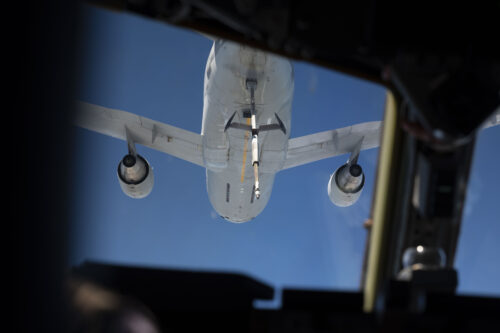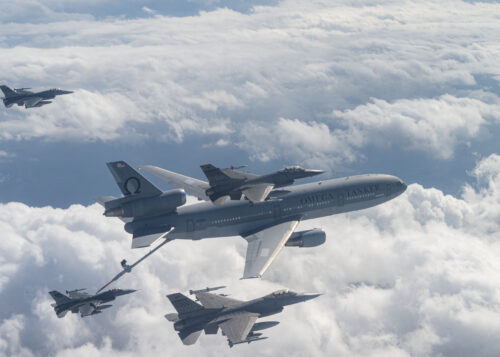In a historic first for U.S. Air Force’s Air Mobility Command, C-17 aircraft from Joint Base Lewis-McChord completed aerial refueling with a commercial KDC-10B tanker on Apr. 10. The mission, executed by Airmen from the 62d Operations Support Squadron and 8th Airlift Squadron, marks a significant milestone in the Air Force’s expanding use of commercial refueling capabilities.

U.S. Air Force photo by Senior Airman Megan Geiger
“This event marks what we believe is the first time a C-17 has refueled with a commercial KDC-10B,” said Lt. Col. Brandon Pasterski, 62d OSS director of operations. The mission leveraged a Pacific Air Forces contract for refueling support in the region.
While this operation represents the first for Air Mobility Command, it builds upon the Air Force’s growing relationship with commercial refueling providers. The U.S. Navy and Marine Corps have utilized commercial refueling for nearly 20 years, but the Air Force only recently began exploring this capability.
The Air Force’s first commercial refueling of fighter aircraft occurred during Exercise Commando Sling 23 in November 2023, when an Omega KDC-10 refueled F-16s from Osan Air Base, Republic of Korea, during their transit to Singapore. That proof-of-concept demonstrated the possibility of using commercial refuelers to support combat aircraft.

The commercial refueling program has grown rapidly since then. On Mar. 10, 2024, an Omega KDC-10 made history by refueling both a B-52 Stratofortress from the 49th Test and Evaluation Squadron and an MC-130J from the 1st Special Operations Squadron near Guam. This operation demonstrated the versatility of commercial refueling across different aircraft types.
“Aerial refueling is the lifeline of military operations in the Pacific due to the tyranny of distance between suitable airfields,” said Lt. Col. Reagan Mullin, 1st Special Operations Squadron director of operations at Kadena Air Base, Japan, following that mission. “The Omega commercial refueling platform offers military aircrew operating in the Pacific with another option to train and obtain mission support when tanker demand exceeds existing military capacity.”
The KDC-10B operated by Omega Air Refueling features an advanced optical sensor system for refueling, similar to the one found on the KC-46 Pegasus. This differs from the traditional boom pod where an operator sits to control refueling, as found on older tanker aircraft like the KC-135 and KC-10.
With the capability of delivering 400-900 gallons of fuel per minute and a capacity of 29,000 gallons (expandable to 41,000 gallons with an additional fuselage tank), the KDC-10B provides substantial support for long-range operations.
Omega Air began building this capability in November 2019 when it took delivery of the first of two former Royal Netherlands Air Force KDC-10 aircraft in San Antonio, Texas. The aircraft, formerly designated T-264 and now registered as N264DE, was Omega’s first boom-equipped tanker, significantly expanding the company’s refueling capabilities.
For the 62d Airlift Wing, this new capability addresses a pressing challenge.
“The 62d AW has limited access to air refueling training, which can impact the currency of our pilots,” explained Maj. Ryan Vigil, 62d OSS director of wing training. With U.S. Air Force tankers in high demand, commercial air refueling offers a potential solution to this challenge.
The training with commercial refuelers remains consistent with established national standards. “The training is very similar to what we experience with the KC-10 and KC-46,” said Vigil, emphasizing the transferable skills gained through this unique training opportunity.
The expansion of commercial refueling capabilities has required extensive coordination across multiple commands. PACAF officials worked with Air Combat Command, Air Force Special Operations Command, Air Force Global Strike Command, Air Force Materiel Command, and the U.S. Navy Program Management Activity to secure Technical Compatibility Assessments for various aircraft types, including the A-10, B-52, C-17, and MC-130J.
“These types of missions significantly advance Total Force power projection capabilities and exponentially increase readiness,” said Col. Jon Baize, Chief of Contingency Operations at Headquarters PACAF. “With commercial air refueling in theater, wings and warfighters saw immediate return on investment, getting training and unique opportunities they otherwise couldn’t get in this AOR due to demand signal for tankers outpacing supply.”
Beyond addressing training requirements, the collaboration with commercial refuelers presents a consistent and reliable platform for air refueling operations. It also frees up military tankers for operational missions.
“To compete and win, the Joint Force needs resilient and diverse ability to get the warfighters where they need to be when they need to be there,” said Lt. Col. Matthew Spinelli, 49th Test and Evaluation Squadron commander. “Having an additional means and capacity depth in our air refueling and logistical movements is critical to success.”
The 62d AW plans to conduct future nighttime refueling missions with the KDC-10B to further evaluate its capabilities and enhance aircrew proficiency.
“We’re proud to have been able to support air refueling training for the C-17A from JBLM,” said Pete Vanagas, Omega Aerial Refueling Services director of U.S. Air Force business development. “This mission was significant because it marked the first instance of contracted air refueling of an Air Mobility Command aircraft. Our team provides air refueling to the Department of Defense whenever and wherever needed. We hope to support the C-17A again in the future and build a long-lasting partnership with the 62d Airlift Wing and Air Mobility Command.”
For more information, hit the Source below